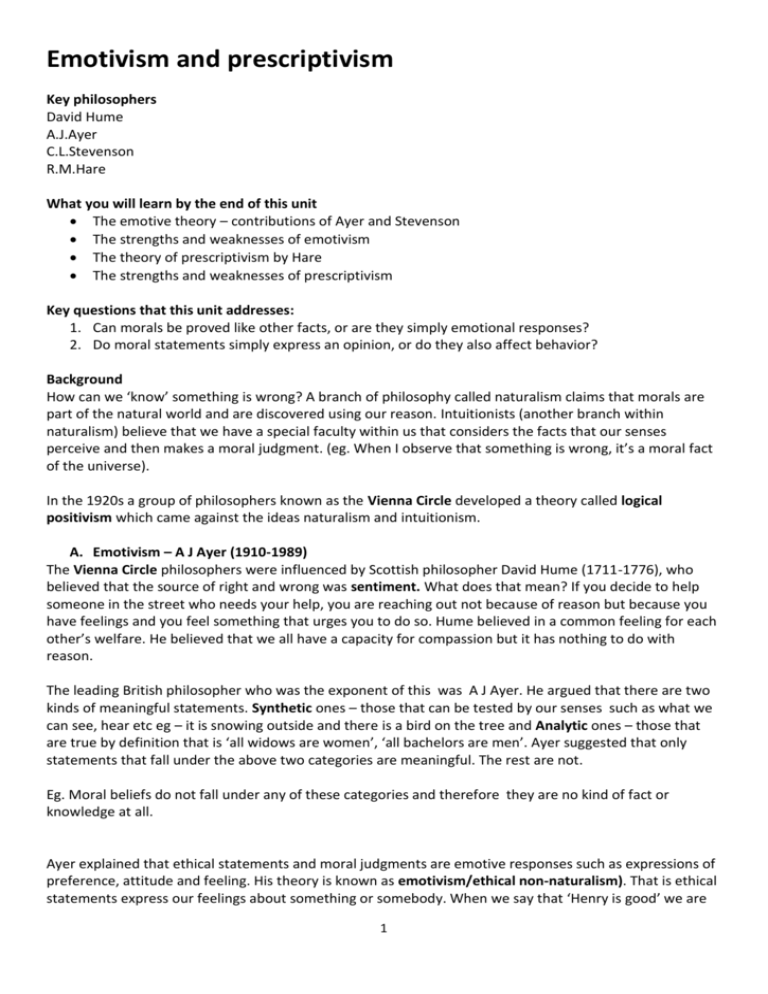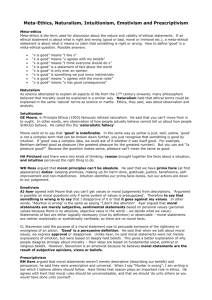Emotivism and prescriptivism
advertisement

Emotivism and prescriptivism Key philosophers David Hume A.J.Ayer C.L.Stevenson R.M.Hare What you will learn by the end of this unit The emotive theory – contributions of Ayer and Stevenson The strengths and weaknesses of emotivism The theory of prescriptivism by Hare The strengths and weaknesses of prescriptivism Key questions that this unit addresses: 1. Can morals be proved like other facts, or are they simply emotional responses? 2. Do moral statements simply express an opinion, or do they also affect behavior? Background How can we ‘know’ something is wrong? A branch of philosophy called naturalism claims that morals are part of the natural world and are discovered using our reason. Intuitionists (another branch within naturalism) believe that we have a special faculty within us that considers the facts that our senses perceive and then makes a moral judgment. (eg. When I observe that something is wrong, it’s a moral fact of the universe). In the 1920s a group of philosophers known as the Vienna Circle developed a theory called logical positivism which came against the ideas naturalism and intuitionism. A. Emotivism – A J Ayer (1910-1989) The Vienna Circle philosophers were influenced by Scottish philosopher David Hume (1711-1776), who believed that the source of right and wrong was sentiment. What does that mean? If you decide to help someone in the street who needs your help, you are reaching out not because of reason but because you have feelings and you feel something that urges you to do so. Hume believed in a common feeling for each other’s welfare. He believed that we all have a capacity for compassion but it has nothing to do with reason. The leading British philosopher who was the exponent of this was A J Ayer. He argued that there are two kinds of meaningful statements. Synthetic ones – those that can be tested by our senses such as what we can see, hear etc eg – it is snowing outside and there is a bird on the tree and Analytic ones – those that are true by definition that is ‘all widows are women’, ‘all bachelors are men’. Ayer suggested that only statements that fall under the above two categories are meaningful. The rest are not. Eg. Moral beliefs do not fall under any of these categories and therefore they are no kind of fact or knowledge at all. Ayer explained that ethical statements and moral judgments are emotive responses such as expressions of preference, attitude and feeling. His theory is known as emotivism/ethical non-naturalism). That is ethical statements express our feelings about something or somebody. When we say that ‘Henry is good’ we are 1 simply expressing our positive feelings towards Henry. This is sometimes called the ‘hurray/boo ‘theory. To say that lying is wrong is to say boo to lying. In doing so we are expressing a feeling against lying. You might reject his theory by saying that you are against lying because Jesus taught about it in the New Testament. Ayer would say you are just looking for other excuses that appeal to your emotions. He rejects traditional moral philosophy. TASKS 1. What did Hume mean when he said that all is sentiment with regards to ethics? (2 points) 2. Explain the difference between synthetic and analytic statements. (4 points) 3. Categorize the following statements as synthetic, analytic or meaningless in emotivist terms and explain your reasoning behind it: a. You are a bad person b. The book is under the bed c. All cats are feline d. Hitler was a German Chancellor e. The boiling point of water is 100 C f. God exists g. Horses exist h. It is wrong to murder i. Has was murdered j. All murder victims have a murderer 4. Ayer’s theory is known as the ‘hurray/boo’ theory. Explain what this means with reference to the statements ‘Euthanasia is wrong’ and ‘A just war is right’. 2 B. Emotivism – C L Stevenson (1908-1979) Another important emotivist who developed Ayer’s ideas was C L Stevenson. Ayer thought that arguments were people simply expressing their emotions towards each other, Stevenson thought something different. He thought that arguments were disagreements in attitudes. He thought that if one says ‘capital punishment is wrong he means that ‘I do not approve of capital punishment, do so as well.’ He believed that such moral statements were not simple expressions of how people feel about something but that they were the result of an attitude based on fundamental beliefs. In this case if I say ‘capital punishment is wrong’ it is because I have an attitude opposing capital punishment and this attitude is based on my fundamental beliefs about the specific subject. Stevenson also pointed out that most moral disagreements are not moral disagreement at all. For example, two doctors may disagree about which method to use to treat a patient but they are not disagreeing about the necessity of treating the patient. Stevenson says this is not a moral disagreement. However if one says it is wrong for a married woman to commit adultery and somebody else says not it is right then there is disagreement over the moral principal. This is due to different fundamental beliefs. The other contribution from Stevenson is that when one says that abortion is wrong, that moral statement is actually seeking to influence others to hold the same attitude against abortion. He is seeking to persuade others to the same opinion. Prescriptivism – R M Hare (1919- ) Unlike emotivist, Hare believed that reason had a role to play in moral statements. He believed that moral statements had a universal character about them. If I say that this is red, I am committed to believe that anything which is like it in color will also be red. This applies to anything similar = and this is a universal statement. Moral judgments have this universal quality to them. Hare supported that when we make moral statements, there are qualities about those moral statements which when found elsewhere, in those situations the same rule applies. Hare suggested that we need to aim to prescribe this universal advice to others as we would to ha e such advice given to us. Tasks 1. Using the terms ‘expression’, ‘attitude’ and ‘belief’ explain first what Ayers argues is meant by the following moral statements and secondly how Stevenson argues is meant by the following moral statements: a. Murder is wrong b. Abortion is good c. Euthanasia is bad d. Genocide is dreadful 2. How does Stevenson’s explanation of moral disagreement differs from Ayer? 3








